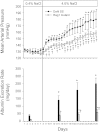Genetic mutation of recombination activating gene 1 in Dahl salt-sensitive rats attenuates hypertension and renal damage
- PMID: 23364523
- PMCID: PMC3602820
- DOI: 10.1152/ajpregu.00304.2012
Genetic mutation of recombination activating gene 1 in Dahl salt-sensitive rats attenuates hypertension and renal damage
Abstract
Hypertension and renal damage in Dahl SS rats are associated with increased infiltrating immune cells in the kidney. To examine the role of infiltrating immune cells in this disease process, a zinc finger nuclease targeting bases 672-706 of recombination-activating gene 1 (Rag1) was injected into the pronucleus of Dahl SS (SS/JrHsdMcwi) strain embryos and implanted in pseudopregnant females. This strategy yielded a rat strain with a 13-base frame-shift mutation in the target region of Rag1 and a deletion of immunoreactive Rag1 protein in the thymus. Flow cytometry demonstrated that the Rag1-null mutant rats have a significant reduction in T and B lymphocytes in the circulation and spleen. Studies were performed on SS and Rag1-null rats fed a 4.0% NaCl diet for 3 wk. The infiltration of T cells into the kidney following high-salt intake was significantly blunted in the Rag1-null rats (1.7 ± 0.6 × 10(5) cells/kidney) compared with the Dahl SS (5.6 ± 0.9 × 10(5) cells/kidney). Accompanying the reduction in infiltration of immune cells in the kidney, mean arterial blood pressure and urinary albumin excretion rate were significantly lower in Rag1-null mutants (158 ± 3 mmHg and 60 ± 16 mg/day, respectively) than in SS rats (180 ± 11 mmHg and 251 ± 37 mg/day). Finally, a histological analysis revealed that the glomerular and tubular damage in the kidneys of the SS rats fed a high-salt diet was also attenuated in the Rag1 mutants. These studies demonstrate the importance of renal infiltration of immune cells in the pathogenesis of hypertension and renal damage in Dahl SS rats.
Figures







References
Publication types
MeSH terms
Substances
Grants and funding
LinkOut - more resources
Full Text Sources
Other Literature Sources
Medical
Molecular Biology Databases

